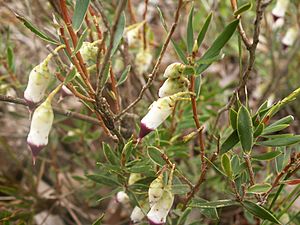Conostephium facts for kids
Quick facts for kids Conostephium |
|
|---|---|
 |
|
| Pearl flower Conostephium pendulum | |
| Scientific classification |
|
| Kingdom: | Plantae |
| Clade: | Tracheophytes |
| Clade: | Angiosperms |
| Clade: | Eudicots |
| Clade: | Asterids |
| Order: | Ericales |
| Family: | Ericaceae |
| Subfamily: | Styphelioideae |
| Tribe: | Styphelieae |
| Genus: | Conostephium Benth |
| Type species | |
| Conostephium pendulum |
|
Conostephium is a group of flowering plants that belong to the Ericaceae family. These plants are often called "pearl flowers" because of their pretty blooms. The name Conostephium comes from two Greek words: conos, meaning "cone," and stephanos, meaning "crown" or "wreath." This name describes the shape of their flowers.
Contents
What They Look Like
Conostephium plants are usually small evergreen shrubs. This means they are woody plants that stay green all year round. They have simple leaves that are small to medium in size.
Their flowers grow one by one where the leaves meet the stem (this spot is called an axil). Each flower has five sepals, which are like small, leaf-like parts that protect the bud. It also has five "petals" that are joined together at their bottom, forming a long tube. Inside the flower, there are five stamens, which are the parts that produce pollen. After the flower blooms, it produces a fruit that is a bit fleshy, called a drupe.
How Scientists Classify Them
There are 12 different kinds, or species, of Conostephium plants. Four of these were discovered and named quite recently.
Scientists look at special features to tell Conostephium plants apart. For example, the flower's tube is shaped like a cone at the top. The petals are very tiny, and the parts that hold pollen (called anthers) are very long and completely hidden inside the flower tube. These features are thought to help with something called buzz pollination. This is when certain bees vibrate their bodies to shake pollen out of the flowers.
Conostephium pendulum was the first species of Conostephium to be officially described by a scientist named George Bentham in 1837. Over time, more species were found and named by different botanists (plant scientists). For example, Michael Hislop, a plant expert from the Western Australian Herbarium, added the newest species in 2013.
Types of Conostephium Plants
Here are the different species of Conostephium recognized by plant experts:
- Conostephium drummondii
- Conostephium hortiorum
- Conostephium laeve
- Conostephium magnum
- Conostephium marchantiorum
- Conostephium minus
- Conostephium papillosum
- Conostephium pendulum
- Conostephium preissii
- Conostephium prolatum
- Conostephium roei
- Conostephium uncinatum
Where They Grow
All Conostephium species are endemic to the southwestern part of Western Australia. This means they naturally grow only in this specific area and nowhere else in the world.
See also
 In Spanish: Conostephium para niños
In Spanish: Conostephium para niños

